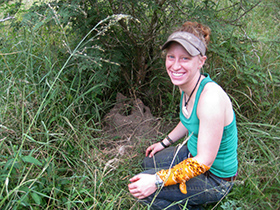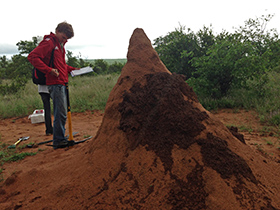When you think about West African savannas, elephants and lions may come to mind. But GǪ termites?
Brianna Lind was studying abroad in South Africa as an undergraduate student at Colby College when she found out she would be learning about termites, instead of typical African animals. She was surprised to learn the unusually large termite mounds have a major impact on the ecosystems and habitat in semi-arid environments, such as the West African Sahelian and Sudanian savannas, areas from which she is now collecting data.
 New Mexico State University Plant and Environmental Sciences doctoral student Brianna Lind is the recipient of a NASA Earth and Space Science Fellowship. Using satellite imagery, Lind is studying the ecosystem effects of large termite mounds in West Africa. She is seen in this photo inspecting termite mounds at Kruger National Park during a study abroad trip to South Africa. (Photo courtesy Brianna Lind) New Mexico State University Plant and Environmental Sciences doctoral student Brianna Lind is the recipient of a NASA Earth and Space Science Fellowship. Using satellite imagery, Lind is studying the ecosystem effects of large termite mounds in West Africa. She is seen in this photo inspecting termite mounds at Kruger National Park during a study abroad trip to South Africa. (Photo courtesy Brianna Lind) |  New Mexico State University Plant and Environmental Sciences doctoral student Brianna Lind is the recipient of a NASA Earth and Space Science Fellowship. Using satellite imagery, Lind is studying the ecosystem effects of large termite mounds in West Africa. One of her field assistants, Brady Ross, is seen here inspecting a termite mound at Kruger National Park during a research trip to South Africa. (Photo courtesy Brianna Lind) New Mexico State University Plant and Environmental Sciences doctoral student Brianna Lind is the recipient of a NASA Earth and Space Science Fellowship. Using satellite imagery, Lind is studying the ecosystem effects of large termite mounds in West Africa. One of her field assistants, Brady Ross, is seen here inspecting a termite mound at Kruger National Park during a research trip to South Africa. (Photo courtesy Brianna Lind) |
"Termite mounds are really big in this area, and they've been around for a really long time," Lind said. "As mounds erode, they take up more and more space in the landscape because it is so difficult for plants to colonize the mound surfaces. They can be over 20 or 30 meters in diameter in this area of Senegal. And they have a really big impact on how water is redistributed in the environment and where plants can grow."
 New Mexico State University Plant and Environmental Sciences doctoral student Brianna Lind is the recipient of a NASA Earth and Space Science Fellowship. Using satellite imagery, Lind is studying the ecosystem effects of large termite mounds in West Africa. The images on the left and in the center (credit: 2016 Digital Globe) are examples of termite mound suppression of grassy biomass using co-located field and aerial photographs over Senegal. The image on the right (credit: Gray Tappan, USGS EROS) provides a closer look at a termite mound with extensive erosional surface.
New Mexico State University Plant and Environmental Sciences doctoral student Brianna Lind is the recipient of a NASA Earth and Space Science Fellowship. Using satellite imagery, Lind is studying the ecosystem effects of large termite mounds in West Africa. The images on the left and in the center (credit: 2016 Digital Globe) are examples of termite mound suppression of grassy biomass using co-located field and aerial photographs over Senegal. The image on the right (credit: Gray Tappan, USGS EROS) provides a closer look at a termite mound with extensive erosional surface.
Lind will join New Mexico State University this fall. She will pursue a doctorate in plant and environmental sciences in the College of Agricultural, Consumer and Environmental Sciences.
The importance of termite research isn't the only thing that has surprised Lind. She recently learned she was the recipient of a NASA Earth and Space Science Fellowship to further her research. She was one of just 69 people out of 385 applicants from across the United States to receive the award.
"Grant and fellowship applications are huge," she said. "They're really time-consuming and difficult, and you put a lot of energy into it. It was a really nice surprise."
Niall Hanan, professor of dryland ecology in the NMSU Department of Plant and Environmental Sciences, is Lind's adviser, and he also worked with her while she was pursing her master's degree in biology at South Dakota State University.
"Brianna is a highly motivated and independent student," Hanan said. "For her master's research, she explored how the diversity of termite species varies across Southern Africa in relation to climate, soil and vegetation types, using termites as a model to explore larger ecological questions about biodiversity. With her NASA Fellowship, Brianna plans to build on that research to study how these small insects, through construction of large termite mounds, act as ecosystem engineers G